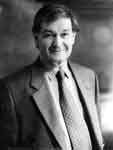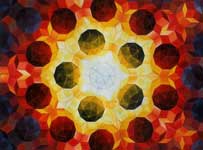- ^ R. Penrose (1979). "Singularities and Time-Asymmetry". S. W. Hawking and W. Israel General Relativity: An Einstein Centenary Survey: 581–638, Cambridge University Press.
- ^ If an Electron Can Be in Two Places at once, Why Can't You?. Retrieved on 2007-12-29.
- ^ Dr. Roger Penrose at Penn State University. Retrieved on 2007-07-09.
- ^ Official announcement knighthood. The London Gazette. 11 June 1994.
- ^ See footnote 52 of Watt, D. C. (1998). Lionel Penrose, F.R.S. (1898-1972) and Eugenics: Part One. Notes and Records of the Royal Society of London, 52, 137-151
.
Roger Penrose
Sir Roger Penrose, OM, FRS (born 8 August 1931) is an English mathematical physicist and Emeritus Rouse Ball Professor of Mathematics at the Mathematical Institute, University of Oxford and Emeritus Fellow of Wadham College. He is renowned for his work in mathematical physics, in particular his contributions to general relativity and cosmology. He is also a recreational mathematician and philosopher. Roger Penrose is the son of scientist Lionel S. Penrose and Margaret Leathes, and the brother of mathematician Oliver Penrose and correspondence chess grandmaster Jonathan Penrose. He was born in Colchester, Essex, England.
Career
Penrose graduated with a first class degree in mathematics from University College London. In 1955, while still a student, Penrose reinvented the generalized matrix inverse (also known as Moore-Penrose inverse, see Penrose, R. "A Generalized Inverse for Matrices." Proc. Cambridge Phil. Soc. 51, 406-413, 1955.) Penrose earned his Ph.D. at Cambridge (St John's College) in 1958, writing a thesis on tensor methods in algebraic geometry under the well known algebraist and geometer John A. Todd. In 1965 at Cambridge, Penrose proved that singularities (such as black holes) could be formed from the gravitational collapse of dying immense stars. (Ferguson, 1991: 66).
In 1967, Penrose invented the twistor theory which maps geometric objects in Minkowski space into the 4-dimensional complex space with the metric signature (2,2). In 1969 he conjectured the cosmic censorship hypothesis. This proposes (rather informally) that the universe protects us from the inherent unpredictability of singularities (such as the one in the centre of a black hole) by hiding them from our view behind an event horizon. This form is now known as the weak censorship hypothesis; in 1979, Penrose formulated a stronger version called the strong censorship hypothesis. Together with the BKL conjecture and issues of nonlinear stability, settling the censorship conjectures is one of the most important outstanding problems in general relativity. Also from 1979 dates Penrose's influential Weyl curvature hypothesis on the initial conditions of the observable part of the Universe and the origin of the second law of thermodynamics.[1]
Roger Penrose is well known for his 1974 discovery of Penrose tilings, which are formed from two tiles that can only tile the plane nonperiodically, and are the first tilings to exhibit fivefold rotational symmetry. In 1984, such patterns were observed in the arrangement of atoms in quasicrystals. Another noteworthy contribution is his 1971 invention of spin networks, which later came to form the geometry of spacetime in loop quantum gravity. He was influential in popularizing what are commonly known as Penrose diagrams (causal diagrams). In 2004 Penrose released The Road to Reality: A Complete Guide to the Laws of the Universe, a 1,099-page book aimed at giving a comprehensive guide to the laws of physics. In the June 2005 issue of Discover magazine[2] , Penrose outlined his interpretation of quantum mechanics. Penrose is currently the Francis and Helen Pentz Distinguished (visiting) Professor of Physics and Mathematics at Penn State University.[3]
Physics and consciousness
Penrose has written controversial books on the connection between fundamental physics and human consciousness. In The Emperor's New Mind (1989), he argues that known laws of physics are inadequate to explain the phenomenon of human consciousness. Penrose hints at the characteristics this new physics may have and specifies the requirements for a bridge between classical and quantum mechanics (what he terms correct quantum gravity, CQG). He claims that the present computer is unable to have intelligence because it is a deterministic system that for the most part simply executes algorithms, as a billiard table where billiard balls act as message carriers and their interactions act as logical decisions. He argues against the viewpoint that the rational processes of the human mind are completely algorithmic and can thus be duplicated by a sufficiently complex computer -- this is in contrast to views, e.g., Biological Naturalism, that human behavior but not consciousness might be simulated. This is based on claims that human consciousness transcends formal logic systems because things such as the insolubility of the halting problem and Gödel's incompleteness theorem restrict an algorithmically based logic from traits such as mathematical insight. These claims were originally made by the philosopher John Lucas of Merton College, Oxford.
In 1994, Penrose followed up The Emperor's New Mind with Shadows of the Mind and in 1997 with The Large, the Small and the Human Mind, further updating and expanding his theories. Penrose's views on the human thought process are not widely accepted in scientific circles. According to Marvin Minsky, because people can construe false ideas to be factual, the process of thinking is not limited to formal logic. Furthermore, he says that AI programs can also conclude that false statements are true, so error is not unique to humans.
Penrose and Stuart Hameroff have speculated that human consciousness is the result of quantum gravity effects in microtubules, which they dubbed Orch-OR (orchestrated objective reduction). But Max Tegmark, in a paper in Physical Review E, calculated that the time scale of neuron firing and excitations in microtubules is slower than the decoherence time by a factor of at least 10,000,000,000. The reception of the paper is summed up by this statement in his support: "Physicists outside the fray, such as IBM's John Smolin, say the calculations confirm what they had suspected all along. 'We're not working with a brain that's near absolute zero. It's reasonably unlikely that the brain evolved quantum behavior', he says." The Tegmark paper has been widely cited by critics of the Penrose-Hameroff proposal. It has been claimed by Hameroff to be based on a number of incorrect assumptions (see linked paper below from Hameroff, Hagan and Tuszyński), but Tegmark in turn has argued that the critique is invalid (see rejoinder link below). In particular, Hameroff points out the peculiarity that Tegmark's formula for the decoherence time includes a factor of T1/2 in the numerator, meaning that higher temperatures would lead to longer decoherence times. Tegmark's rejoinder keeps the factor of T1/2 for the decoherence time.
Awards and honours
Penrose has been awarded many prizes for his contributions to science. He was elected a Fellow of the Royal Society of London in 1972. In 1975, Stephen Hawking and Penrose were jointly awarded the Eddington Medal of the Royal Astronomical Society. In 1985, he was awarded the Royal Society Royal Medal. Along with Stephen Hawking, he was awarded the prestigious Wolf Foundation Prize for Physics in 1988. In 1989 he was awarded the Dirac Medal and Prize of the British Institute of Physics. In 1990 Penrose was awarded the Albert Einstein Medal for outstanding work related to the work of Albert Einstein by the Albert Einstein Society. In 1991, he was awarded the Naylor Prize of the London Mathematical Society. From 1992 to 1995 he served as President of the International Society on General Relativity and Gravitation. In 1994, Penrose was knighted for services to science.[4] In 1998, he was elected Foreign Associate of the United States National Academy of Sciences. In 2000 he was appointed to the Order of Merit. In 2004 he was awarded the De Morgan Medal for his wide and original contributions to mathematical physics. To quote the citation from the London Mathematical Society:
His deep work on General Relativity has been a major factor in our understanding of black holes. His development of Twistor Theory has produced a beautiful and productive approach to the classical equations of mathematical physics. His tilings of the plane underlie the newly discovered quasi-crystals.
In 2005 Penrose was awarded an honorary doctorate (Honoris Causa) by Warsaw University and Katholieke Universiteit Leuven (Belgium), and in 2006 by the University of York. He is also a Distinguished Supporter of the British Humanist Association.
Miscellany
* Penrose has an Erdős number of three.
* Penrose and his father shared mathematical concepts with Dutch graphic artist M. C. Escher which were incorporated into a number of pieces, including Waterfall and Up and Down.
* J. C. Raven's 1936 MSc thesis features introspections from Penrose, aged four and two thirds, as he solved what are now known as Raven's Progressive Matrices[5].
Personal life
* Father: Lionel S. Penrose
* Mother: Margaret Leathes
* Brother: Oliver Penrose (mathematician)
* Brother: Jonathan Penrose (chess master)
* Wife: Vanessa Thomas (two children)
* Three sons from first marriage, to an American, Joan Isabel Wedge. Married in 1959.
Books
* Roger Penrose, Techniques of Differential Topology in Relativity, Society for Industrial & Applied Mathematics, 1972, ISBN 0-89871-005-7 (rare)
* Roger Penrose and Wolfgang Rindler, Spinors and Space-Time: Volume 1, Two-Spinor Calculus and Relativistic Fields, Cambridge University Press, 1987 (reprint), ISBN 0-521-33707-0 (paperback)
* Roger Penrose and Wolfgang Rindler, Spinors and Space-Time: Volume 2, Spinor and Twistor Methods in Space-Time Geometry, Cambridge University Press, 1988 (reprint), ISBN 0-521-34786-6 (paperback)
* Roger Penrose, The Emperor's New Mind: Concerning Computers, Minds, and The Laws of Physics, Oxford University Press, 1989, ISBN 0-14-014534-6 (paperback). Received the Rhone-Poulenc science book prize in 1990.
* Roger Penrose, Shadows of the Mind: A Search for the Missing Science of Consciousness, Oxford University Press, 1994, ISBN 0-19-853978-9 (hardback)
* Stephen Hawking and Roger Penrose, The Nature of Space and Time, foreword by Michael Atiyah, University Press, 1996, ISBN 0-691-03791-4 (hardback), ISBN 0-691-05084-8 (paperback)
o Hawking's part is freely available at: http://arxiv.org/abs/hep-th/9409195
* Roger Penrose, The Large, the Small, and the Human Mind, (with Abner Shimony, Nancy Cartwright, and Stephen Hawking), Cambridge University Press, 1997, ISBN 0-521-56330-5 (hardback), ISBN 0-521-65538-2 (paperback), Canto edition: ISBN 0-521-78572-3
* Brian Aldiss and Roger Penrose, White Mars Or, The Mind Set Free, Little, Brown, 1999, ISBN 978-0-316-85243-2 (hardback)
* Roger Penrose, The Road to Reality: A Complete Guide to the Laws of the Universe, Jonathan Cape, London, 2004, ISBN 0-224-04447-8 (hardcover), ISBN 0-09-944068-7 (paperback)
See also
* Penrose stairs
* Penrose triangle
* Penrose inequalities
* Moore-Penrose pseudoinverse
* Weyl curvature hypothesis
* Frame Dragging
* Newman-Penrose formalism
References
* Ferguson, Kitty (1991). Stephen Hawking: Quest For A Theory of Everything. Franklin Watts. ISBN 0-553-29895-X.
* Misner, Charles; Thorne, Kip S. & Wheeler, John Archibald (1973). Gravitation. San Francisco: W. H. Freeman. ISBN 0-7167-0344-0. ; see Box 34.2.
Links
* O'Connor, John J. & Robertson, Edmund F., “Roger Penrose”, MacTutor History of Mathematics archive
o Beyond the Doubting of a Shadow: A Reply to Commentaries on Shadows of the Mind
* Penrose Tiling found in Islamic Architecture
* Two theories for the formation of quasicrystals resembling Penrose tilings
* Tegmark, Max. 2000. "The importance of quantum decoherence in brain processes". Physical Review E. vol 61. pp. 4194-4206.
o "Biological feasibility of quantum states in the brain" -(a disputation of Tegmark's result by Hagan, Hameroff, and Tuszyński)
+ Tegmarks's rejoinder to Hagan et al
* "Toilet Paper Plagiarism" – D. Trull about Penrose's lawsuit concerning the use of his Penrose tilings on toilet paper
Retrieved from "http://en.wikipedia.org/"
All text is available under the terms of the GNU Free Documentation License




